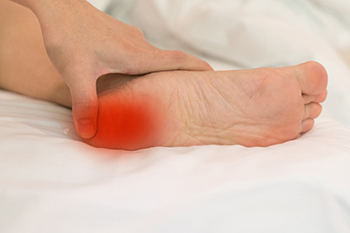 When the corner of a toenail grows into the surrounding skin instead of over it, an ingrown toenail can form. While an ingrown toenail can happen to any of the toes, it usually occurs on the big toe. Ingrown toenails can develop for several reasons like cutting the toenail too short, rounding the corner of the nail when cutting it, wearing shoes that are too tight, or trauma, such as stubbing the toe. The most prevalent symptom of an ingrown toenail is pain where the nail is growing into the skin, and a red or swollen appearance to the affected skin. Ingrown toenails can also get infected and may drain pus. If you have an infected ingrown toenail or one that is very painful, it is suggested that you consult with a podiatrist.
When the corner of a toenail grows into the surrounding skin instead of over it, an ingrown toenail can form. While an ingrown toenail can happen to any of the toes, it usually occurs on the big toe. Ingrown toenails can develop for several reasons like cutting the toenail too short, rounding the corner of the nail when cutting it, wearing shoes that are too tight, or trauma, such as stubbing the toe. The most prevalent symptom of an ingrown toenail is pain where the nail is growing into the skin, and a red or swollen appearance to the affected skin. Ingrown toenails can also get infected and may drain pus. If you have an infected ingrown toenail or one that is very painful, it is suggested that you consult with a podiatrist.
Ingrown toenails can become painful if they are not treated properly. For more information about ingrown toenails, contact Dr. Alexander Terris of Total Foot Care. Our doctor can provide the care you need to keep you pain-free and on your feet.
Ingrown Toenails
Ingrown toenails occur when a toenail grows sideways into the bed of the nail, causing pain, swelling, and possibly infection.
Causes
Prevention
Because ingrown toenails are not something found outside of shoe-wearing cultures, going barefoot as often as possible will decrease the likeliness of developing ingrown toenails. Wearing proper fitting shoes and using proper cutting techniques will also help decrease your risk of developing ingrown toenails.
Treatment
Ingrown toenails are a very treatable foot condition. In minor cases, soaking the affected area in salt or antibacterial soaps will not only help with the ingrown nail itself, but also help prevent any infections from occurring. In more severe cases, surgery is an option. In either case, speaking to your podiatrist about this condition will help you get a better understanding of specific treatment options that are right for you.
If you have any questions please feel free to contact our office located in Wilmington, DE . We offer the newest diagnostic and treatment technologies for all your foot and ankle needs.
Read more about Ingrown Toenail Care When it comes to heel pain one of the best ways to get an accurate diagnosis is to describe the location of the pain to your podiatrist. The sources of heel pain vary, depending on exactly where the heel hurts. For example, pain in the back of the heel may indicate a problem with the Achilles tendon, bursa, soft tissues and bones, or the heel’s growth plate. Pain on the bottom of the heel may be caused by plantar fasciitis or fat pad atrophy. Treatments for heel pain differ, depending on the underlying cause of the pain. In addition to taking a medical history, your podiatrist will also complete a physical examination and undergo various tests or imaging studies, such as X-rays or ultrasounds, to confirm a diagnosis. If you are experiencing heel pain, it is suggested that you schedule an appointment with a podiatrist near you.
When it comes to heel pain one of the best ways to get an accurate diagnosis is to describe the location of the pain to your podiatrist. The sources of heel pain vary, depending on exactly where the heel hurts. For example, pain in the back of the heel may indicate a problem with the Achilles tendon, bursa, soft tissues and bones, or the heel’s growth plate. Pain on the bottom of the heel may be caused by plantar fasciitis or fat pad atrophy. Treatments for heel pain differ, depending on the underlying cause of the pain. In addition to taking a medical history, your podiatrist will also complete a physical examination and undergo various tests or imaging studies, such as X-rays or ultrasounds, to confirm a diagnosis. If you are experiencing heel pain, it is suggested that you schedule an appointment with a podiatrist near you.
Many people suffer from bouts of heel pain. For more information, contact Dr. Alexander Terris of Total Foot Care. Our doctor can provide the care you need to keep you pain-free and on your feet.
Causes of Heel Pain
Heel pain is often associated with plantar fasciitis. The plantar fascia is a band of tissues that extends along the bottom of the foot. A rip or tear in this ligament can cause inflammation of the tissue.
Achilles tendonitis is another cause of heel pain. Inflammation of the Achilles tendon will cause pain from fractures and muscle tearing. Lack of flexibility is also another symptom.
Heel spurs are another cause of pain. When the tissues of the plantar fascia undergo a great deal of stress, it can lead to ligament separation from the heel bone, causing heel spurs.
Why Might Heel Pain Occur?
Treatments
Heel pain should be treated as soon as possible for immediate results. Keeping your feet in a stress-free environment will help. If you suffer from Achilles tendonitis or plantar fasciitis, applying ice will reduce the swelling. Stretching before an exercise like running will help the muscles. Using all these tips will help make heel pain a condition of the past.
If you have any questions please contact our office located in Wilmington, DE . We offer the newest diagnostic and treatment technologies for all your foot and ankle needs.
Read more about Heel Pain
Have your child's feet been examined lately? Healthy feet are happy feet. If your child is complaining of foot pain, it may be a sign of underlying problems.
 Plantar fasciitis is a common foot injury in which the plantar fascia becomes inflamed. The plantar fascia is a ligament that runs along the bottom of the foot, connecting the heel bone to the toes. This ligament can become damaged when it is strained through repetitive overuse or a sudden increase in physical activity, such as running. Standing for prolonged periods of time, exercising on hard surfaces, and wearing shoes that lack proper support or fit poorly can also injure the plantar fascia. People who have flat feet or high arches, are overweight, have had foot or ankle injuries, or are over age 40 are more likely to develop plantar fasciitis. If you are suffering from foot pain, please seek the care of a podiatrist for diagnosis and treatment options.
Plantar fasciitis is a common foot injury in which the plantar fascia becomes inflamed. The plantar fascia is a ligament that runs along the bottom of the foot, connecting the heel bone to the toes. This ligament can become damaged when it is strained through repetitive overuse or a sudden increase in physical activity, such as running. Standing for prolonged periods of time, exercising on hard surfaces, and wearing shoes that lack proper support or fit poorly can also injure the plantar fascia. People who have flat feet or high arches, are overweight, have had foot or ankle injuries, or are over age 40 are more likely to develop plantar fasciitis. If you are suffering from foot pain, please seek the care of a podiatrist for diagnosis and treatment options.
Plantar fasciitis is a common foot condition that is often caused by a strain injury. If you are experiencing heel pain or symptoms of plantar fasciitis, contact Dr. Alexander Terris from Total Foot Care. Our doctor can provide the care you need to keep you pain-free and on your feet.
What Is Plantar Fasciitis?
Plantar fasciitis is one of the most common causes of heel pain. The plantar fascia is a ligament that connects your heel to the front of your foot. When this ligament becomes inflamed, plantar fasciitis is the result. If you have plantar fasciitis you will have a stabbing pain that usually occurs with your first steps in the morning. As the day progresses and you walk around more, this pain will start to disappear, but it will return after long periods of standing or sitting.
What Causes Plantar Fasciitis?
There are some risk factors that may make you more likely to develop plantar fasciitis compared to others. The condition most commonly affects adults between the ages of 40 and 60. It also tends to affect people who are obese because the extra pounds result in extra stress being placed on the plantar fascia.
Prevention
There are a variety of treatment options available for plantar fasciitis along with the pain that accompanies it. Additionally, physical therapy is a very important component in the treatment process. It is important that you meet with your podiatrist to determine which treatment option is best for you.
If you have any questions, please feel free to contact our office located in Wilmington, DE . We offer the newest diagnostic and treatment technologies for all your foot care needs.
Read more about Plantar Fasciitis

Walking is a great low-impact form of exercise. The best part is, you don’t need much more than an even surface and a good walking shoe. Walking shoes should — above all else — be comfortable. Look for a feeling of stability and flexibility, particularly in the toes. Toe boxes should have enough room to freely wiggle and bend the toes, but not so much room that your foot shifts around. Check for padding to provide shock absorption without weighing the shoe down. Contouring should hug the heels, midfoot and sole. The heel counter, which hugs the back of the heel, should cup the heel and support it without being too tight. For professional advice on walking shoes, and the specific features to complement your particular foot and gait, please consult with a podiatrist.
For more information about walking shoes versus running shoes, consult with Dr. Alexander Terris from Total Foot Care. Our doctor can measure your feet to determine what your needs are and help you find an appropriate pair of footwear.
Foot Health: The Differences between Walking & Running Shoes
There are great ways to stay in shape: running and walking are two great exercises to a healthy lifestyle. It is important to know that running shoes and walking shoes are not interchangeable. There is a key difference on how the feet hit the ground when someone is running or walking. This is why one should be aware that a shoe is designed differently for each activity.
You may be asking yourself what the real differences are between walking and running shoes and the answers may shock you.
Differences
Walking doesn’t involve as much stress or impact on the feet as running does. However, this doesn’t mean that you should be any less prepared. When you’re walking, you land on your heels and have your foot roll forward. This rolling motion requires additional support to the feet.
Flexibility – Walking shoes are designed to have soft, flexible soles. This allows the walker to push off easily with each step.
If you have any questions, please feel free to contact our office located in Wilmington, DE . We offer the newest diagnostic and treatment technologies for all your foot care needs.
Read more about Differences between Walking and Running Shoes